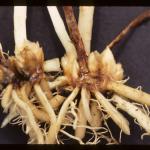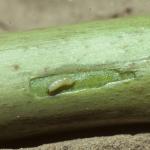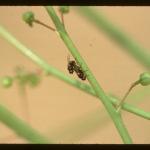Asparagus Miner
Ophiomyia simplex
This fly was introduced to North America from Europe and is present wherever asparagus is grown. It feeds only on asparagus, and is found primarily on older stalks bearing ferns.
Identification:
The adult fly is shiny black, 3-4mm long, with clear wings. Larvae are whitish, legless, tapered at both ends, with black mouth hooks at one end. Pupation takes place in the larval mine on the stalk. The pupa becomes darker brown with age and is 4-5mm long.
Life Cycle:
Overwintering puparia are usually in mines near or below ground level. There are two generations per year. Adults emerge in May and lay eggs underneath the epidermis of stems, usually near the base of the plant. Larva feed in June, pupate inside their larval mines, and a second generation of adults emerges and lays eggs in late July or early August. Second generation larvae feed through August and pupate in the fall, overwintering until the following spring.
Crop Injury:
Larvae feed just beneath the surface of the stem, burrowing upwards or downwards and forming mines. While direct feeding damage can girdle stems if there are several mines per stalk, its effect on yield is minimal. The most important injury from leaf miner is due to its association with Fusarium spp. and its ability to vector this pathogen into the plant through feeding wounds. See Asparagus Fusarium Root and Crown Rot for more information on this disease.
Monitoring & Thresholds:
Currently there are no treatment thresholds for asparagus miner.
Cultural Controls & Prevention:
- Remove overwintering stalks and any wild asparagus in the vicinity of commerical plantings.
- Select varieties that are resistant to Fusarium, such as Jersey Giant, Jersey Supreme, or Jersey Knight. This is the most important step to reduce the impact of asparagus miner.
Biological Controls:
There are several parasitoids have been documented in asparagus miner in both the US and British Isles, however the extent of their impact is not well known.
Chemical Controls & Pesticides:
There are no established treatment thresholds for chemical control of this pest, as the primary controls are cultural.
Insecticides
For current information on production methods (including varieties, spacing, seeding, and fertility), weed, disease, and insect management, please visit the New England Vegetable Management Guide website.
Crops that are affected by this insect:
The Center for Agriculture, Food and the Environment and UMass Extension are equal opportunity providers and employers, United States Department of Agriculture cooperating. Contact your local Extension office for information on disability accommodations. Contact the State Center Director’s Office if you have concerns related to discrimination, 413-545-4800 or see ag.umass.edu/civil-rights-information.


